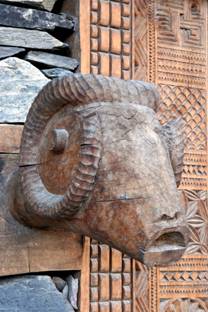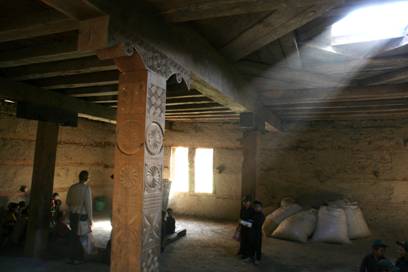After attending the service at the Saint Sarkis Church, Kensington, London, 16/2/2014 and having read the pamphlet that was handed out on the "
Feast of St. Sarkis and Church Name Day"
It was reading phrases in that pamphlet such as "
King Julian" and "
(Sarkis') only son Martyros" that vexed me.
This would not be the first case of history being remodelled for the "lives of the Saints"
So I decided to see what Wikipedia has on Saint Sarkis, I copy below some from
their article:
"Saint Sarkis the Warrior (Armenian: Սուրբ Սարգիս Զորավար, c. 4th century, died 362-363) also known as Saint Sarkis the Greek was a Centurion in the Roman Empire. Sarkis was a contemporary of the ruling Constantinian dynasty and the Arsacid dynasty of Armenia."
So it is made clear that he was a Greek.
"Little is known on the origins and early life of Sarkis. Sarkis is thought to have been an Armenian or an Anatolian Greek from the plains of Cappadocia."
Um, it has already been stated in his epithet "Saint Sarkis the Greek"
"Sarkis was appointed by the Roman emperor Constantine the Great as General in Chief of the region of Cappadocia bordering Armenia. Sarkis was reputed to possess the characteristics of piety, faith and valor, and used his position for spiritual growth, teaching the gospel and church building.
"General in Chief of the region of Cappadocia" would have been the military commader for Cappadocia with his headquarters at Caesarea.
The Gospels were known already, certainly in Cappadocia, since
Saint Gregory was raised as a Christian in it's capital, Caesarea, setting out to convert the Kingdom of Armenia by 301 A.D.
Also the
Edict of Milan in 313 A.D. made life for Christians in all of the Roman Empire, tolerable.
In that year, Cappadocia was part of the Eastern Empire under the rule of Emperor
Licinius.
Constantine’s nephew Julian the Apostate became emperor in 361 and set about persecuting Christians throughout the Roman Empire. Sarkis was deeply concerned about the these events and prayed for a solution. Jesus is said to have appeared to Sarkis and uttered the words: "It is time for you to leave your country and your clan, as did Abraham the Patriarch, and go to a country which I will show you. There you will receive the crown of righteousness prepared for you." Sarkis then left his military position and authority and, with his son Mardiros, sought refuge in Armenia under the protection of King Tiran (Tigranes VII). As Julian and his army advanced toward Antioch Syria slaughtering Christians, Tiran urged Sarkis and Mardiros to leave Armenia for the Sassanid Empire.
No mention is made of the fact that Julian had spent his youth in Cappadocia and was a Baptised Christian, reverting to "Paganism" when he was around 20 years old.
Further, there are no historical records of Julian and his army slaughtering Christians as they advanced towards Antioch, the then capital of Syria.
However, Julian saught to revive the "Pagan" traditions of Antioch. Most of all, and also unmentioned, is that he saught to root out state corruption, especially by the wealthy merchant classes of Antioch.
King Tiran had been dead for 11 years by 361 A.D. having died in 350 A.D.
So did Sarkis meet the ghost of Tiran?
There was an instance of "military commanders" leaving Armenia for the court of Shapur II.
Well, leaving is an understatement, more they defected.
This happened, for example with
Meruzhan Artsruni, who defected with his forces to Shapur II in around 360-361 A.D.
"Sassanid emperor Shapur II, hearing of Sarkis' reputation as a skilled military commander, appointed him to command the Sassanid army."
It is highly unlikely Shapur II would have risked upsetting his Nakhvadars (from which the Armenian title "Nakharar" comes from) and Spah Pati (akin to the Armenian Sparapet) by given supreme command to a Greek Christian.
If Shapur II ever used Greek (Roman) mercenaries in his army, he could
have deployed them to conduct surveillance in an invading Roman army,
such as that of Julian II when he campaigned into northern Mesopotamia
on the
5th of March 363 A.D.
"Sarkis credited God for his military victories, which included fending off Julian’s troops entering into Shapur’s kingdom. Sarkis urged troops serving with him to be believe in the Creator of Heaven and earth and their hearts would never be shaken."
"Creator of Heaven and earth (sic)" is quite an ambiguous title, not purely stating Jesus Christ.
For the Zoroastrians,
Ahura Mazda was the Creator of the Universe, including Earth.
"
To the Emperor Caesar Flavius Constantinus, the greatest, pious, and blessed Augustus: because he, inspired by the divine, and by the greatness of his mind, has delivered the state from the tyrant and all of his followers at the same time, with his army and just force of arms, the Senate and People of Rome have dedicated this arch, decorated with triumphs."
Constantine, whilst having signed the Edict of Milan, was an open worshipper of
Sol.
He was baptised on his death bed.
"Some of Sarkis’ soldiers were baptized by travelling priests of the Sassanid army, yet some who were not baptized went to Shapur II and had told him about the religious beliefs of Sarkis. After realizing that Sarkis was a Christian, Shapur called up Sarkis, his son Mardiros and his 14 soldier companions who were newly baptized back to his palace."
Shapur II was vehemently Zoroastrian and against any other religion that would upset the State.
However there was already a large Christian population in Mesopotamia by the time of Shapur II.
Why would Shapur II allow "travelling priests" into the Sasanian army when his policy was anti-Christian?
"Shapur ordered Sarkis, Mardiros and Sarkis’ companions to participate and offer sacrifices in a Zoroastrianism ceremony in a pagan temple. Sarkis refused Shapur’s orders and said: ‘We should worship one God – the Holy Trinity, which has created the earth and the heaven. Whereas fire or idols are not gods and the human being may destroy them’."
This is strangely reminiscent of what Saint Gregory is said to have responded to King Tiridates III when asked to participate in ceremonies at the royal Temple.
This is removed from the Wikipedia article on Saint Gregory.
I quote from the book "The History Of My Ancestors" published in July 1978 by the Mekhitarist Fathers of the Island of San Lazzaro:
"- You place some branches too, Gregory - said Dertades.
- No, I do not wish to make an offering to a statue. I am a Christian - Gregory replied" ~ The History Of My Ancestors, page 32.
I doubt the venerable Mekhitarist Fathers of the Island of San Lazzaro would make that up.
Even more strange, whereas Sarkis previously stated "the Creator of Heaven and Earth" he later states the "Holy Trinity, which has created the Earth and the Heaven".
Make your mind up Sarkis.
Also "sacrifices in a Zoroastrianism ceremony in a pagan temple" is a misnomer since a Zoroastrian Temple is, a Zoroastrian Temple. Shapur II was against heresies and would only have officiated in a Zoroastrian Temple.
Also the only "sacrifices" to the Eternal Fire was Sandalwood.
"After Sarkis responded to the Sassanid King, Sarkis destroyed all the items in the temple which annoyed the surrounding crowd who fell on him and his son."
What items, the Sacred Fire?
So the Temple Guards did not stop him? And the crowd saw him do this, whilst they were outside the Temple?
If the crowd "fell on him and his son" then that would have been the end of them, surely they would have torn them to pieces.
Yet, apparently not:
"Shapur outraged by Sarkis’ actions, had his son Mardiros killed before his eyes and had his 14 companions beheaded. Sarkis was put in prison and Shapur hearing that Sarkis was strengthened by his relationship with the Lord in prison outraged him so much, Shapur ordered Sarkis’ execution."
Ironically, Sarkis' son was martyred and his name was
Mardiros which is the Greek word for martyr.
In Western Armenian the name is rendered as "Martyros".
Same meaning. That was never his original name.
14 seems to have a special symbolism, 14 years was also given for the amount of time Saint Gregory was meant to have been imprisoned at Khor Virap.
It is surprising that after such sacrilege, Shapur did not have Sarkis executed too.
Sarkis seems to have enraged Shapur II whilst in prison so much that he was executed, yet at around the same time from 363 - 370 A.D. King Arshak II, a staunch Christian and opponent to Shapur II was imprisoned by Shapur II and was never executed.
He killed himself.
Conclusions
The "Armenian" saint Sarkis is said to be one and the same as the Greek saint
Sergius.
Rather than having a son called "Martyros/Mardiros" he had a companion called Bacchus.
Even then, how could such an espoused, fervent Christian, retain an obviously "pagan" name as Bacchus, the Roman equivalent of the Greek "pagan" God, Dionysus.
Legend has them active at the time of the Eastern Emperor,
Galerius.
However, if they ever existed,
historical research puts them active in the reign of Emperor Julian II.
Just as Saint Sarkis and Martyros/Mardiros are supposed to have been active in that Emperor's reign.
So "Martyros/Mardiros" the martyred son may well be Bacchus.
If Sergius/Sarkis was real and appointed to be a commander of the military forces of Cappadocia in the era of Constantine, circa 337 A.D. (when Constantine died) lets say Sergius/Sarkis was around 37 years old.
Ablabius was the father-in-law to King Arshak II, who married Ablabius' daughter,
Olympias.
The Eastern Emperor Constantius II later had Ablabius executed for his pro-Nicene Christian sympathies in 338 A.D.
Constantius II was successful in defending the eastern frontier against Shapur II in the region of war, in Syria and northern Mespotamia from 337 - 340 A.D.
In 360 A.D. Constantius II was the sole Emperor and faced a determined attack on the eastern frontiers by Shapur II, when
Singara, amongst other strong fortresses, were captured.
It would have been useful to Shapur II to have renegades from the Roman army.
Again, it would have been useful to Shapur II to have renegades from the Roman army.
By 363 A.D. Sergius/Sarkis would have been 63 and he could have had a son, who was also serving in the army. Rather than being called "martyr" he might have had a real name, like Bacchus.
After
Julian II's death in 363 A.D. the Roman army of the campaign chose Jovian, who quickly signed over Mesopotamia to Shapur II.
Both Sergius and Sarkis died and were buried in the region of the war.
Sergius at
Resafa in northern Syria, just south of the Euphrates.
Sarkis is just stated as being buried in a village called "Namyan" in Assyria.
Bachus died at
Barbalissos, a little to the north-west of Resafa.
What seems to end up in Christian Martyrology often has a dubious if not awkward origin.
Were Sergius/Sarkis and Bacchus/Martyros in the pay of Shapur II?
And so found out and executed by Julian II?










































